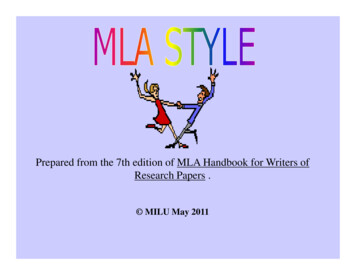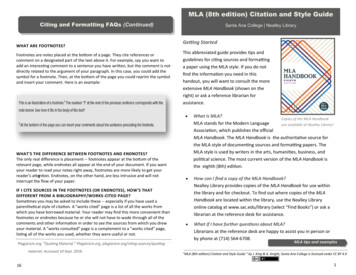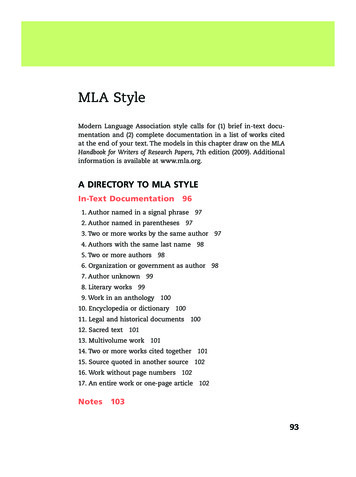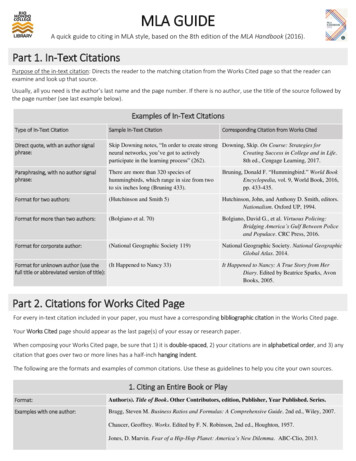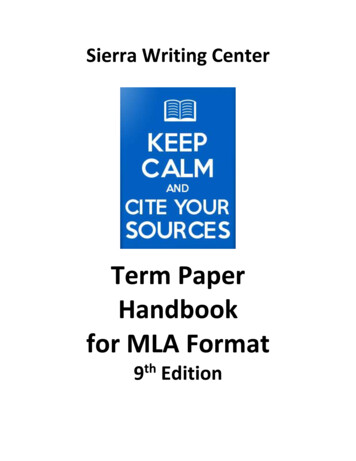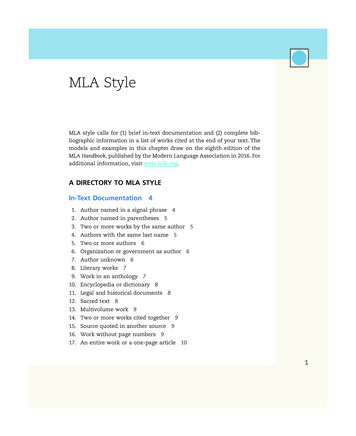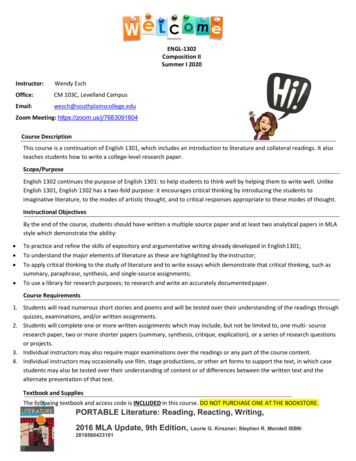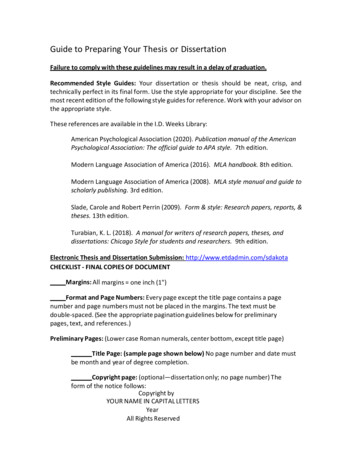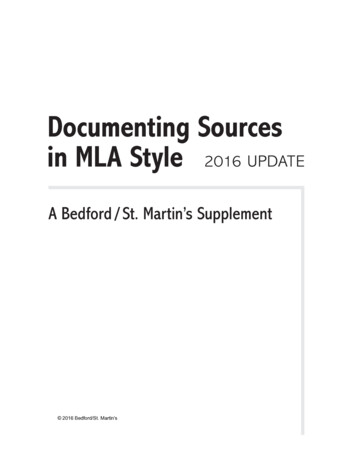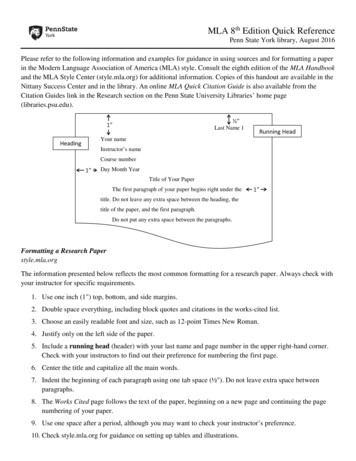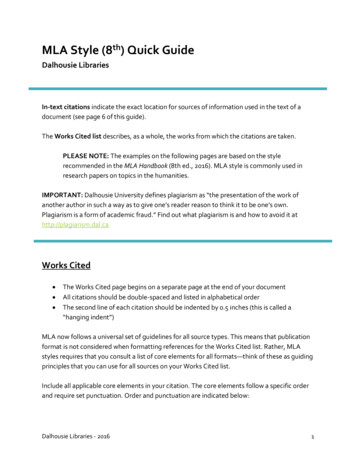
Transcription
MLA Style (8th) Quick GuideDalhousie LibrariesIn-text citations indicate the exact location for sources of information used in the text of adocument (see page 6 of this guide).The Works Cited list describes, as a whole, the works from which the citations are taken.PLEASE NOTE: The examples on the following pages are based on the stylerecommended in the MLA Handbook (8th ed., 2016). MLA style is commonly used inresearch papers on topics in the humanities.IMPORTANT: Dalhousie University defines plagiarism as “the presentation of the work ofanother author in such a way as to give one’s reader reason to think it to be one’s own.Plagiarism is a form of academic fraud.” Find out what plagiarism is and how to avoid it athttp://plagiarism.dal.ca.Works Cited The Works Cited page begins on a separate page at the end of your documentAll citations should be double-spaced and listed in alphabetical orderThe second line of each citation should be indented by 0.5 inches (this is called a“hanging indent”)MLA now follows a universal set of guidelines for all source types. This means that publicationformat is not considered when formatting references for the Works Cited list. Rather, MLAstyles requires that you consult a list of core elements for all formats—think of these as guidingprinciples that you can use for all sources on your Works Cited list.Include all applicable core elements in your citation. The core elements follow a specific orderand require set punctuation. Order and punctuation are indicated below:Dalhousie Libraries - 20161
1.2.3.4.5.6.7.8.9.Author.Title of source.Title of container,Other contributors,Version,Number,Publisher,Publication date,Location.Please note, the core element “location” does not refer to place of publication; rather, itrepresents the location of electronic texts, usually represented as a URL or a Digital ObjectIdentifier (DOI).SAVE TIME: Use RefWorks to easily keep track of your references and quickly andcorrectly format them for your Works Cited list. RefWorks is a personal bibliographiccitation managing system that Dalhousie University subscribes to. For moreinformation, go to: ple references for Works CitedBooksBasic format for booksLast Name, First Name. Title of Book. Publisher, Publication Date.Number of or type of authorOne authorTwo authorsWright, Julia. Representing the National Landscape in Irish Romanticism.Syracuse UP, 2014.Diepeveen, Leonard, and Timothy Van Laar. Artworld Prestige: ArguingCultural Value. Oxford UP, 2012.Dalhousie Libraries - 20162
Three or more authorsTwo or more books bythe same authorWysocki, Anne Frances, et al. Writing New Media: Theory and Applications forExpanding the Teaching of Composition. Utah State UP, 2004.List works alphabetically by title (but ignore articles like A, An and The).Luckyj, Christina. The Duchess of Malfi: A Critical Guide. Continuum, 2011.Book with no authorBook by a corporateauthor or organization---. "A Moving Rhetoricke:" Gender and Silence in Early Modern England.Manchester UP, 2002.Encyclopedia of Indiana. Somerset, 1993.American Psychological Association. Publication Manual of the AmericanPsychological Association. 5th ed., American PsychologicalAssociation, 2001.Type of workA translated bookA work prepared by aneditorA subsequent editionof a workAn anthology orcollectionGarcía Márquez, Gabriel. Living to Tell the Tale. Translated by Edith Grossman,Knopf, 2003.Ten Fifteenth-Century Comic Poems. Edited by Melissa Furrow, Garland Press,1985.Crowley, Sharon, and Debra Hawhee. Ancient Rhetorics for ContemporaryStudents. 3rd ed., Pearson, 2004.Irvine, Dean, editor. Auto-Anthology: The Complete Poems and Translations ofF.R. Scott, 1918-1984. Canadian Poetry Press, 2007.Cawsey, Kathleen, and Jason Harris, editors. Transmission and Transformationin the Middle Ages: Texts and Contexts. Four Courts Press, 2007.A work in an anthology Basic format:or collection (or a book Last name, First name. "Title of Essay/Chapter." Title of Collection/Book,chapter)edited by Editor's Name(s), Publisher, Year, Page range of entry.Enns, Anthony. “The Undead Author: Spiritualism, Technology andAuthorship.” The Ashgate Research Companion to Victorian Spiritualismand the Occult, edited by Tatiana Kontou and Sarah Willburn, Ashgate,2012, pp. 55-78.Dalhousie Libraries - 20163
Article in a referencebook (such as anencyclopedia ordictionary)A multivolume work“Abjection.” The Oxford Dictionary of Literary Terms. 3rd ed., 2008.Citing a single volume:Quintilian. Institutio Oratoria. Translated by H. E. Butler, vol. 2, Loeb-HarvardUP, 1980.Citing all volumes:Quintilian. Institutio Oratoria. Translated by H. E. Butler, Loeb-Harvard UP,1980. 4 vols.ArticlesArticle in a scholarlyjournalArticle in a magazineArticle in a newspaperA reviewBasic format:Author(s). "Title of Article." Title of Journal, Volume, Issue, Year, pages.Ross, Trevor. “Translation and the Canonical Text.” Studies in the LiteraryImagination, vol. 33, no. 2, 2000, pp. 1-21.Funicello, Dori. “Portugal’s Reign of Terror.” National Review, 19 Aug. 1999,pp. 34-37.Jonas, Jack. “A Visit to a Land of Many Facets.” Washington Star, 5 Mar. 1961,p. F4.Basic format:Review Author. "Title of Review (if there is one)." Review of Performance Title,by Author/Director/Artist. Title of Periodical, Day Month Year, page.Burt, Struthers. “John Cheever’s Sense of Drama.” Review of The Way SomePeople Live, by John Cheever. Saturday Review, 24 April 1943, p. 9.Dalhousie Libraries - 20164
Dissertations and thesesPublishedUnpublishedCarlson, William Robert. Dialectic and Rhetoric in Pierre Bayle. Dissertation,Yale University, 1973. Macmillan, 1977.Carlson, William Robert. “Dialectic and Rhetoric in Pierre Bayle.” Dissertation,Yale University, 1973.Electronic sourcesAn entire websiteA page on a websiteAn article in a webmagazineAn article in an onlinescholarly journal(accessed directly fromthe publisher)An article in an onlinescholarly journal(accessed through anonline database)Basic format:Editor, author, or compiler name (if available). Name of Site. Version number,Name of institution/organization affiliated with the site (sponsor or publisher),date of resource creation (if available), URL, DOI or permalink. Date of access(if applicable).The Purdue OWL Family of Sites. The Writing Lab and OWL at Purdue andPurdue U, 2008, owl.english.purdue.edu/owl. Accessed 23 Apr. 2008.“MLA Style.” The Purdue OWL Family of Sites. The Writing Lab and OWL atPurdue and Purdue U, 2008, owl.english.purdue.edu/owl/section/2/11.Accessed 18 Sep. 2016.Jacobus, Mark. “Reading Cy Twombly.” The Paris Review, 16 Sep. g-cy-twombly.Accessed 18 Sep 2016Please note: if the Digital Object Identifier (DOI) is available, include the DOInumber instead of the URLBennett, Lyn. “Women, Writing, and Healing: Rhetoric, Religion, and Illness inAn Collins, “Eliza,” and Anna Trapnel.” Journal of Medical Humanities,vol. 36, no. 2, 2015, pp. 157-170, doi: 10.1007/s10912-015-9328-6.Please note: if the Digital Object Identifier (DOI) is available, include the DOInumber instead of the URLGreenfield, Bruce. “’Now Reader Read’: The Literary Ambitions of HenryKelsey, Hudson's Bay Company Clerk.” Early American Literature, vol.47, no. 1, 2012, pp. 31-58. JSTOR, www.jstor.org/stable/41705641.Accessed 18 Sep. 2016.Dalhousie Libraries - 20165
An email (includingemail interviews)A Youtube videoEnglish, Sam. “Re: Romantic Literature.” Received by Wanda White, 20 Aug.2016.If the author’s name is the same as the video uploader, you only need to cite theauthor once. If the author is different from the uploader, cite the author’s namebefore the title and the uploader’s name following “YouTube.” See examples,below, for clarification.British Library. “Virginia Woolf’s ‘Mrs Dalloway.’” YouTube, 24 May 2016,www.youtube.com/watch?v QM-fyF7xFtk.McGonigal, Jane. “Gaming and Productivity.” YouTube, uploaded by BigThink, 3 July 2012, www.youtube.com/watch?v mkdzy9bWW3E.In-Text CitationsAccording to MLA style, you acknowledge your sources by including parenthetical citationswithin your text. These refer the reader to the alphabetical list of Works Cited that appears atthe end of the document. For example:The close of the millennium was marked by a deep suspicion of the natural worldand an increasing reliance “upon the pronouncements of soothsayers andvisionaries, who caused hysteria with their doom-laden forecasts of the end ofhumanity” (Mulligan 234).The citation – (Mulligan 234) – informs the reader that the quotation originates on page 234 ofa work by an author named Mulligan. Consulting the Works Cited list, the reader would find thefollowing information under the name Mulligan:Mulligan, Grant V. The Religions of Medieval Europe: Fear and the Masses. London:Secker, 1977.Dalhousie Libraries - 20166
The Works Cited might list a second work by this author, which, in accordance with MLA style,would appear in the list with three hyphens substituting for the author’s name:---, The Tudor World. London: Macmillan, 1981.In this case, the parenthetical reference above would include more information in order toclarify which of the two books contains the quoted passage. Usually, a shortened form of thetitle is sufficient: (Mulligan, Religions 234).Parenthetical references should be kept as brief as clarity will permit. If the in-text citationclearly shows which document in the Works Cited the quoted or paraphrased text refers to,then no further identification is needed:Reva Basch reports that the Georgetown Center for Text and Technology, whichhas been compiling a catalogue of electronic text projects, lists “over 300 suchprojects in almost 30 countries” (14).The parenthetical reference – (14) – in combination with the mention of Reva Basch at thebeginning of the passage, makes it clear to the reader that the quoted text comes from page14 of the following document listed on the Works Cited page:Basch, Reva. “Books Online: Visions, Plans, and Perspectives for Electronic Text.”Online, vol. 15, no. 4, 1991, pp. 13-23.If the author of a source is unknown, use a shortened title of the work instead. Article titlesshould be put in quotations marks. Titles of longer works, such as books and entire websites,should be italicized. Wherever possible, provide a page number.Dalhousie Libraries - 20167
Dalhousie Libraries - 2016 1 MLA Style (8th) Quick Guide Dalhousie Libraries In-text citations indicate the exact location for sources of information used in the text of a document (see page 6 of this guide). The Works Cited list describes, as a whole, the works from which the citations are taken. PLEASE NOTE: The examples on the following pages are based on the style
